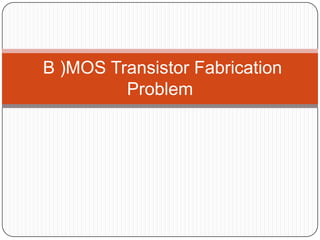
B )mos transistor fabrication problem
- 1. B )MOS Transistor Fabrication Problem
- 2. 1. Identify the two problem that exist in CMOS Ttransistor operation: A) Latch up - CMOS transistor not functioning properly. - If the transistor gain and resistance increase continuously, latch-up current can permanently damage or destroying junctions. Therefore, the transistor can’t be use. B ) parasitic capacitance - limiting their high frequency performance - It becomes a problem with higher frequencies because the very small distributed capacitances that exist will have lower impedances at these frequencies
- 3. 2. Explain latch up and parasitic capacitance effects on circuit operation A ) latch up CMOS transistor not functioning properly. If the transistor gain and resistance increase continuously, latch-up current can permanently damage or destroying junctions. Therefore, the transistor can’t be use. B ) parasitic capacitance simulate grounding shorts, line linkage, feedback paths and other generally undesirable features in the circuit.
- 4. 3. Explain methods to overcome latch up and parasitic capacitance problems in IC fabrication A ) latch up Latch up Protection Technology circuit were used. Move n well and n+ farther apart. Reduce the well and substrate resistances B ) parasitic capacitance A P-well blocked layer is formed directly beneath a parasitic device. Partially disconnects the parasitic device from the ground terminal to minimize the effective capacitive impedance that is added to the total termination impedance.
- 5. 4. Compare CMOS technology i.e P – well, N-well, twin –tub, and SOI in terms of circuit performance due to latch up and parasitic capacitance Type of CMOS Latch up P – well •Latch up problem arise. • Parasitic capacitance higher due to no insulator. N – well •Latch up problem arise. • Parasitic capacitance higher due to no insulator. Twin – tub •Reliability higher due to lower in parasitic capacitance. SOI •No latch up • Smaller parasitic capacitance
- 6. C. Scalling Effect in MOS Devices
- 7. 1. Explain MOS Scaling Theory Technology scaling rate is approximately13% / year, halving every 5 years. Besides increasing the number of devices, scaling has had a profound impact on both speed and power. Keeping the electric field patterns constant avoids breakdown and other secondary effects. This leads to greater device density, higher speed and reduced power consumption.
- 8. 2. Explain scaling impacts on circuits performance and power Circuits performance Accuracy specification Weak inversion operation power consumption. accuracy, bandwidth or speed of
- 9. 3. Explain CMOS scaling technology evolution : A ) Submicron The sub-micron CMOS technology has channel length less than 1 micrometer
- 10. B ) deep - submicron deep sub micron refers to any technology smaller than 180 nano or .18 micron currently we have reached till 32 nano.
- 11. C ) nanotechnology Nano-processors with declining energy Ultra-small terra-bit level storage GHz frequency and bandwidth Integrated nano-sensors
